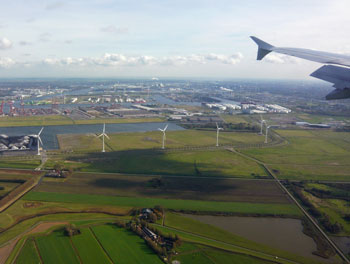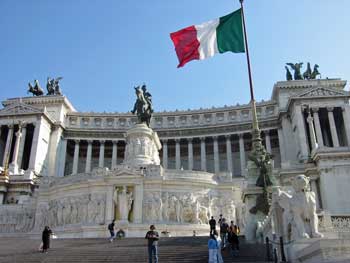3 Weird and disturbing facts about US to Europe airfares in 2014
Recently I updated and expanded my article from last year showing the cheapest European airports to fly into from the US and Canada. You might find the list itself interesting, especially as this year I also broke it down into the 10 cheapest destinations from each of the major North American cities.
By popular demand, I added Atlanta to the test, which was otherwise made up of only the largest cities in the US and Canada. I’d heard many times before that fares from Atlanta are unusually high due to the fact that Delta Airlines has almost no competition on those routes, especially those to Europe. Still, it was shocking to see that flights starting from Houston and Los Angeles are that much cheaper to Europe than those starting from Atlanta.
The test only confirmed what many people knew or suspected about Atlanta airfares, but there were two other odd and somewhat disturbing things I discovered in all the data. Namely that nonstop flights between North America and Europe are now prohibitively expensive for most of us, and that the longest connecting flights are often the cheapest, in spite of jet fuel cost issues.
1 – Average fares from 6 major US & Canadian cities to 24 European cities
- New York City: $916
- Toronto: US$932
- Houston: $994
- Chicago: $1,073
- Los Angeles: $1,112
- Atlanta: $1,251
Note: the averages above are only from the tests I performed for the article linked at the top, not universal averages for all flights for all times of year.
Lesson 1: People from Atlanta get screwed by Delta’s near-monopoly
Hartsfield–Jackson Atlanta International Airport is the world’s busiest, yet since Delta Airlines has a virtual monopoly on international flights (especially to Europe), flyers on average pay more to fly across the Atlantic than any other major city. Both Houston and Los Angeles have much better fares, in spite of all the extra time and fuel it takes to reach Europe.
Lesson 2: You can’t save money by flying to another airport first
Have you ever seen a unusually high airfare and wondered if you could save money by flying to another airport first that has lower fares? According to this data, that would almost never work. It should actually be comforting to know that you’ll do best by just shopping among the flights leaving from your main airport, rather than trying to hack the system using two round-trips to cross the Atlantic.
Of course you might think that people from Atlanta would do better by flying to New York or Toronto or Houston first, but the problem is that those flights out of Atlanta are very expensive as well.
2 – Non-stop flights to Europe are now a premium (expensive) product

This year I didn’t find any examples of this, and the gap between the cheapest fare and the cheapest nonstop fare got much wider. It’s clear that the airlines have each pushed up their nonstop fares to Europe to as near the breaking point as possible. If I owned an airline I’d probably do it too, but the point for us travelers is that nonstop flights now occupy territory between connecting flights and business class seats. Those who insist on a nonstop flight will pay dearly for it.
Some examples:
New York City to Istanbul
- Cheapest: Aeroflot via Moscow – US$860
- Cheapest nonstop: Turkish Airlines – $1,281
The ironic thing here is that Turkish Airlines has great fares to almost everywhere else in Europe, changing planes in Istanbul.
New York City to Amsterdam
- Cheapest: Aer Lingus via Dublin – $932
- Cheapest nonstop: Lufthansa – $1,491
New York City to Rome
- Cheapest: Norwegian via Copenhagen – $917
- Cheapest nonstop: American Airlines – $1,630
- Cheapest Alitalia nonstop: $1,640
Alitalia doesn’t seem to have good fares anywhere in Europe, including to Italy.
New York City to London
- Cheapest: Aer Lingus via Shannon – $872
- Cheapest non-stop: Virgin Atlantic – $1,413
New York City to London is one of the world’s busiest international routes so you might assume that competition would be fierce. But nonstops on FinnAir, British Airways, Iberia, American, Delta, and United were all between $1,413 and $1,464. In other words, the airlines treat the nonstops as a premium product, so they only compete within a narrow range that is about 50% higher than the 1-stop flights.
3 – The longest flights and connections are often the cheapest, in spite of high fuel prices

There is literally an inverse relationship to the distances these flights travel and how much they charge for a seat. In other words, the longer flights with longer and less convenient connections are cheaper than convenient ones, and nonstop flights are the most expensive of all.
Some examples, again:
New York City to Rome
- Cheapest: Norwegian via Copenhagen – US$917
- Next cheapest: SAS via Oslo – $923
- Cheapest nonstop: American Airlines – $1,630
New York City to Istanbul
- Cheapest: Aeroflot via Moscow – US$860
- Cheapest nonstop: Turkish Airlines – $1,281
These are only two examples of dozens that I encountered during this test.
Flying to Rome through Denmark or Norway adds several thousand kilometers to the total trip, as does flying to Istanbul through Moscow. Yet somehow they can still make a profit and offer the lowest fares on that route overall.
If conserving jet fuel is such a high priority, you wonder why airlines encourage flyers to use so much extra by offering the lowest prices on the longest routes? And what about the environmental concerns of providing incentives to passengers to travel the greatest distance to get the lowest fares?
It’s not labor and facility costs
When you see that Aeroflot offers cheap fares through Moscow you might assume that they can offer lower fares because labor costs in Russia tend to be lower than in Western Europe.
But Norwegian, SAS, and SWISS all have low fares on their awkwardly connecting flights as well, and those airlines operate in the most expensive labor markets in the world, not to mention all the other costs of doing business in Norway, Sweden, Denmark, and Switzerland.
Reality check: The bottom line

The algorithms for maximizing revenue for each seat on each flight get more sophisticated every year, and these are the new (or at least current) realities. We just have to do our best to be aware of them, and vote with our feet by not patronizing airlines that are offering prices that seem unfair.
Unfortunately, most of us continue to complain endlessly about companies like Ryanair and Spirit Airlines, and then just keep flying them because they still offer the lowest fares. It all boils down to supply and demand, multiplied by the unfortunate lack of real competition in places like Atlanta.

When I moved to Atlanta five years ago, I was so excited to be closer to Europe, envisioning long weekend trips to London, etc.
I love travel.
Then….I shopped for tickets. It is truly a shame that the same ticket to London is 1400.00 from the ATL compared to a ticket out of NY or just about anywhere else is nearly half of that when deals are in play.
Just…depressing. Nothing can be done I guess. Save up and pay more. Or move.ha.
Nina,
Yes, it is shocking and disappointing. I’ve looked into this quite a bit and it’s also frustrating that there are no semi-reasonable airports anywhere within driving distance. You could drive to, say, Jacksonville, and maybe save just a bit, but it’s not worth it. It’s really a shame. -Roger
Read this – a return ticket with KLM to NYC JFK can be bought at about 550 euros, about 620 USD. You can only buy this in Europe, departure from Amsterdam. Taking the same flights (even done by the same carriers, Delta or KLM) starting from JFK are 1100 USD; almost DOUBLE the cost. Same airport fees, same distance, same carrier. The only difference: the closed market in the US. Dominated by Delta and supported by United and American.
Oh . .and have you heard the key values that Delta so proudly conveys every flight ? Honesty, Integrity, Respect …. Hahahaha
I fly to Europe almost every year in the summer. I am appalled at the prices this year. Last year, I booked at ticket to WAW from ORD on May 1 with United (July 3 to July 15) and it was $1075. This was the cheapest flight, a direct flight to WAW with LOT was more than $200 more. Right now, same flight on United is $1490, direct flight with LOT is $1325. WTF!
Roger: your are right. I reversed the destinations, WAW -> ORD, ORD -> to WAW, I found tickets for $906 with Alitalia. WTF!! and if you change the date of departure, I found it for less than $700, round trip.
Freaking Airlines are gouging people flying from US overseas.
I did find this:
http://qz.com/178531/heres-why-you-shouldnt-buy-a-us-to-europe-flight-more-than-two-months-in-advance/
I will wait in May and see what happens.
I used flights.google.com
Tom,
That’s a bit shocking how much cheaper those fares are when starting from Europe instead of the US. As per the suggestion above, I’m going to run tests soon on that myself, and it looks pretty dramatic. I’ve written quite a bit on the timing of the lowest fares, including the data they used in the article you linked here. That seems to be a different issue from the possible differences in which continent you start a round-trip from.
But overall airlines actually don’t make much money, and it’s been a money-losing industry for much of the past couple decades so I’m more sympathetic than most. If they can fill planes at higher prices starting in the US than they can elsewhere, it’s hard to see why they would keep them artificially lower just out of some sense of “fairness” between Europeans and North Americans. It’s still depressing though. Thanks for the info here. -Roger
Why are round trips in the opposite direction (Europe to US and back)$300 cheaper?
Jay,
That’s an interesting question. I just tried a few searches and some were about the same price, and others were cheaper starting in Europe. I’m going to run a bigger test in the coming weeks and if the results show any definite trends, I will write about it on the site.
Assuming it is generally true, I’d have to think it has to do with airlines feeling that they can get more out of Americans than they can out of Europeans. As the data in this post suggests, airfare pricing seems to be much more about supply and demand, and very little about the actual cost of each flight. Thanks for another worthwhile topic to investigate. -Roger